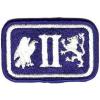Всесвітня військова енциклопедія
> США
> Нашивки
> Нарукавні нашивки Сухопутних військ
> Армійські корпуси
> US-PTACR-00017

Нарукавний знак 19 корпусу СВ США
Випадкові:

Нарукавний знак Сухопутних військ Швейцарії

National Guard patche, 5 variant /Latvian National Armed Forces/

Staff battalion Honour Guard (Godasardzes) company qualification sign - "For strength", golden /Latvian National Armed Forces/
Змінити інформацію
Description
On a medium Blue disc 2 5/8 inches (6.67cm) in diameter with a 1/8 inch (.32cm) Silver Gray border, a tomahawk Proper (black handle, a silver gray blade and bindings and red tassel).
Symbolism
In April 1944, over the signature of General Eisenhower, it was stated that a design "of American significance" was desired by the Corps Commander of the XIX Corps. The tomahawk is one of the most American of symbols. The Indian tomahawk was combined with a peace pipe and was thus ceremonially representative of war or peace. In the peace ceremony the blade was buried and the peace pipe smoked, while in war it was used as a weapon rather that as a pipe.
Background
The distinctive unit insignia was approved for the XIX Corps on 3 May 1944. It was amended 9 Mar 1949, to change the wording of the description to conform with the shoulder sleeve insignia manufactured and worn by the personnel of the XIX Corps overseas during World War II, the design was a slight variance from the originally approved design. (TIOH Drawing Number A-1-74)
On a medium Blue disc 2 5/8 inches (6.67cm) in diameter with a 1/8 inch (.32cm) Silver Gray border, a tomahawk Proper (black handle, a silver gray blade and bindings and red tassel).
Symbolism
In April 1944, over the signature of General Eisenhower, it was stated that a design "of American significance" was desired by the Corps Commander of the XIX Corps. The tomahawk is one of the most American of symbols. The Indian tomahawk was combined with a peace pipe and was thus ceremonially representative of war or peace. In the peace ceremony the blade was buried and the peace pipe smoked, while in war it was used as a weapon rather that as a pipe.
Background
The distinctive unit insignia was approved for the XIX Corps on 3 May 1944. It was amended 9 Mar 1949, to change the wording of the description to conform with the shoulder sleeve insignia manufactured and worn by the personnel of the XIX Corps overseas during World War II, the design was a slight variance from the originally approved design. (TIOH Drawing Number A-1-74)
Ще з цієї категорії: Армійські корпуси
 Нарукавний знак 21 корпусу СВ США
Нарукавний знак 21 корпусу СВ США
 Нарукавний знак 6 корпусу СВ США
Нарукавний знак 6 корпусу СВ США
 Нарукавний знак 2 корпусу СВ США
Нарукавний знак 2 корпусу СВ США
 Нарукавний знак 3 корпусу СВ США
Нарукавний знак 3 корпусу СВ США
 Нарукавний знак 24 корпусу СВ США
Нарукавний знак 24 корпусу СВ США

